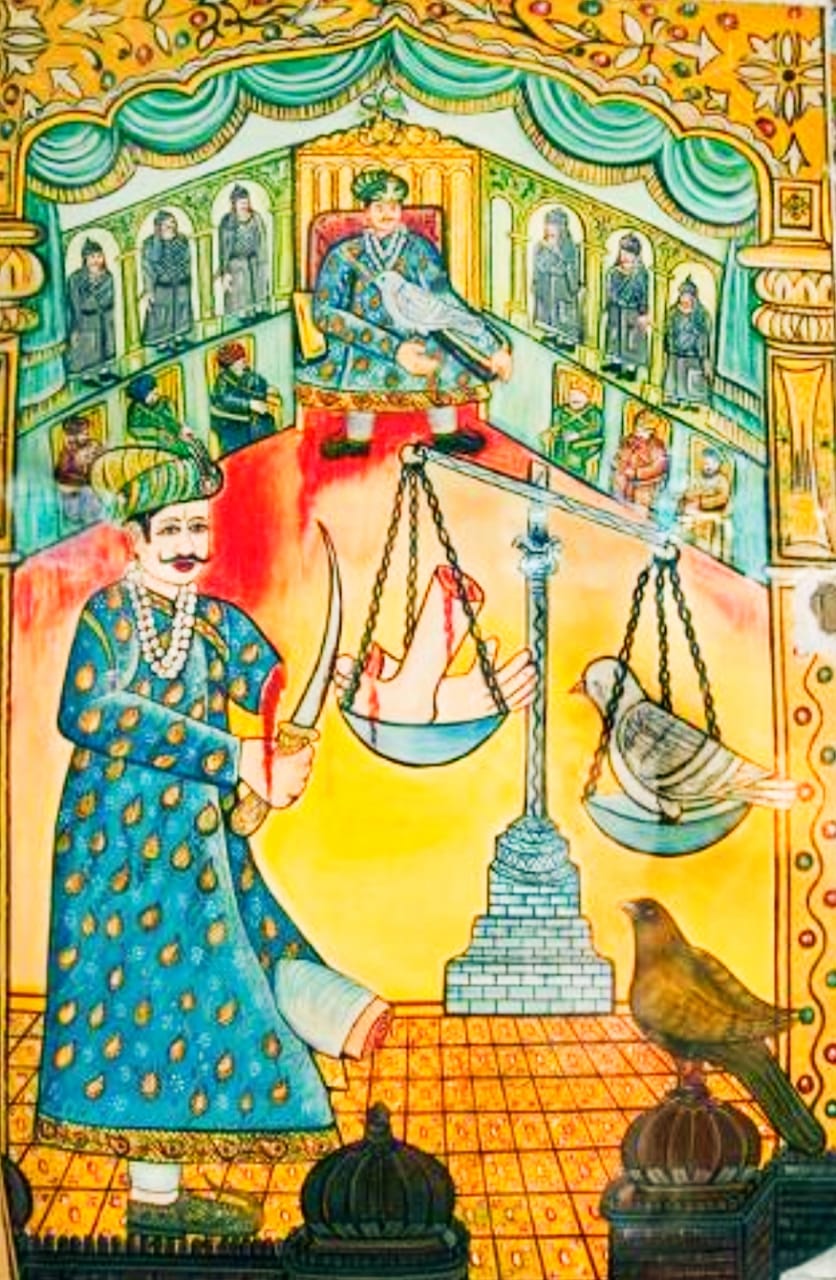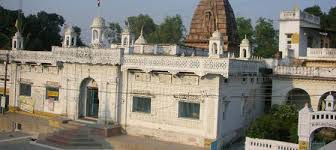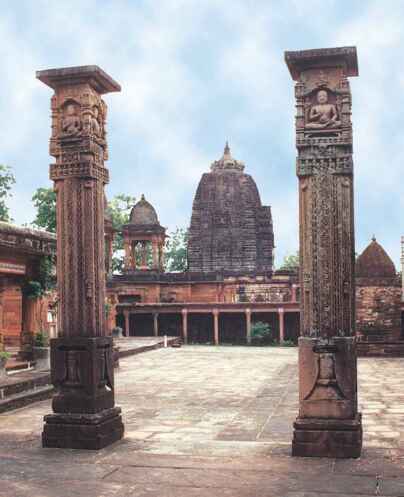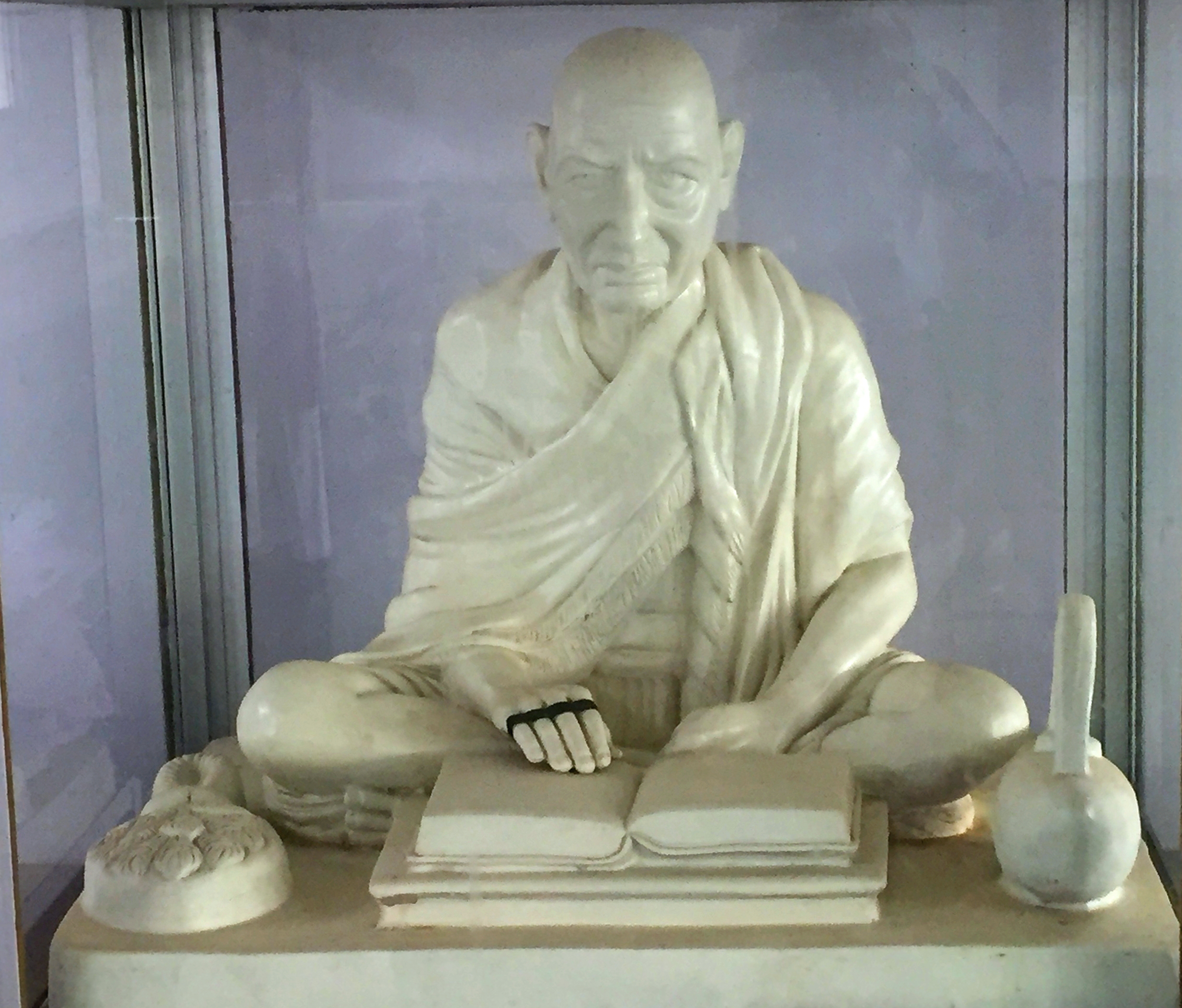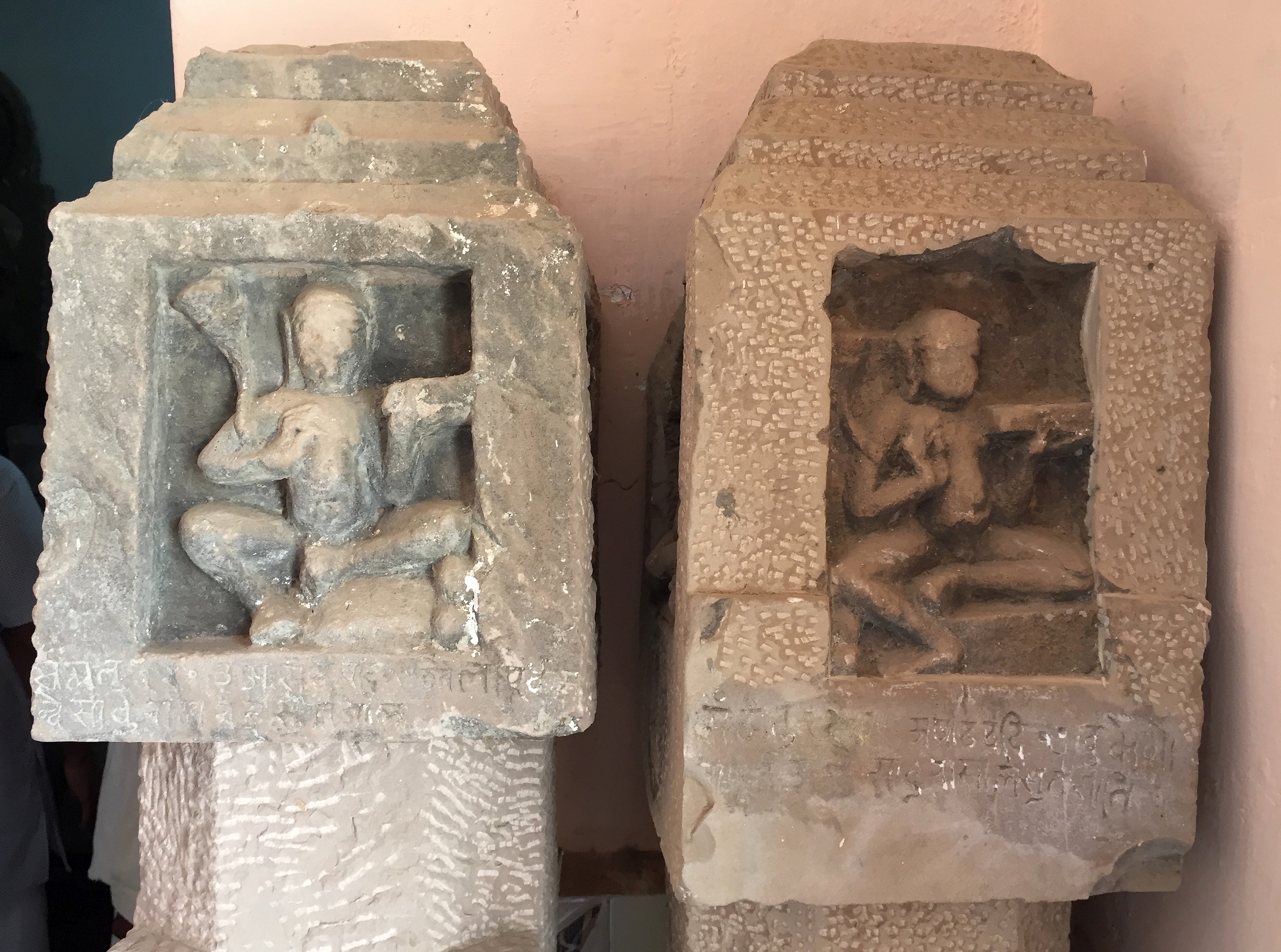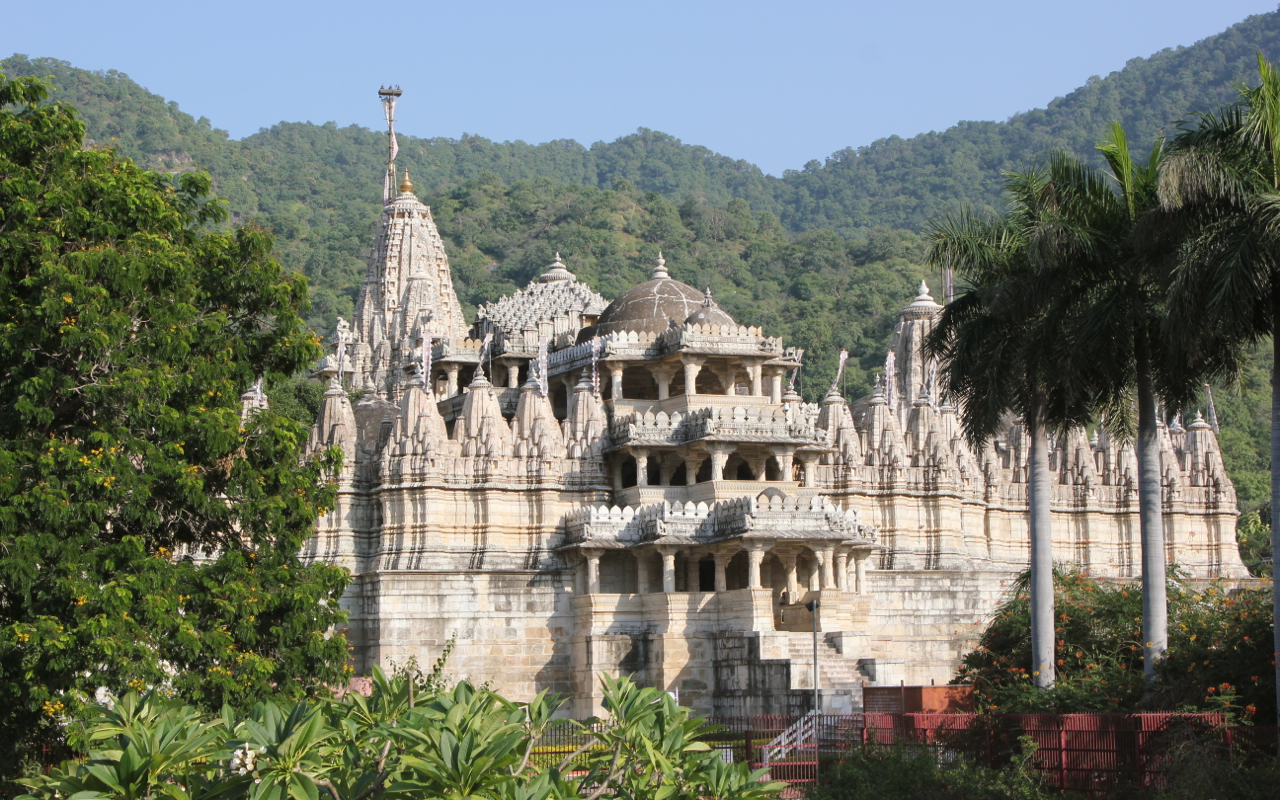|
Aharji
Aharji is a historical pilgrimage site for Jainism in India. It is located in the central Indian state of Madhya Pradesh, on the road from Tikamgarh to Chhatarpur. This place is famous for Jain Temple. Aharji Jain Teerth Aharji is a place full of natural attractive beauty. It is famous for the miraculous colossus of Lord (Shantinath) in standing (Khadagasana) posture. It is 18 feet in height. The main temple is famous for beautiful monumental image of Lord Shatinath from the Chandella period. It has an inscription on it of 1180 AD (Vikram Samvat 1237). It was the last major temple to be built here in the Chandella period. Several other smaller temples were built here at the same time as the main temple. Excavations have found a large number of Jain images that were installed here during 954 to 1275 AD (Samvat 1011 to Samvat 1332), spanning the reigns of six Chandella rulers. This was a major Jain center during the Chandella period. The inscriptions give the names of 32 separ ... [...More Info...] [...Related Items...] OR: [Wikipedia] [Google] [Baidu] |
Shantinath
Śāntinātha () or Śānti is the sixteenth of Jainism in the present age (). According to traditional accounts, he was born to King Vishvasena and Queen Aćira of the Ikshvaku dynasty in the north Indian city of Hastinapur. His birth date is the thirteenth day of the Jyest Krishna month of the Indian calendar. He was also a and a . He ascended to the throne when he was 25 years old. After over 25,000 years on the throne, he became a Jain monk and started his penance. After renunciation, the legends state that he travelled without food and sleep and after sixteen years received his first ' (food) after achieving . He attained ''Moksha'' on Sammed Shikharji and became a siddha, a liberated soul which has destroyed all of its karma. Along with Rishabhanatha, Neminatha, Parshvanatha and Mahavira, Shantinatha is one of the five Tirthankaras who attract the most devotional worship among the Jains. His icons include the eponymous deer as his emblem, the Nandi tree, ''Garuda ... [...More Info...] [...Related Items...] OR: [Wikipedia] [Google] [Baidu] |
Tikamgarh
Tikamgarh (also spelled as Tikamgadh)is a town and a tehsil in Tikamgarh district in the Indian state of Madhya Pradesh. The city serves as a district headquarters. The earlier name of Tikamgarh was Tehri (i.e., a triangle) consisting of three hamlets, forming a rough triangle. In Tikamgarh town there is locality still known as 'Purani Tehri' (Old Tehri). Until Indian independence in 1947, Tikamgarh, formerly called Tehri, was part of the kingdom of Orchha, which was founded in the 16th century by the Bundeli chief Rudra Pratap Singh, who became the first King of Orchha. In 1783 the capital of the state was moved to Tehri, about south of Orchha, which was home to the fort of Tikamgarh, and the town eventually took the name of the fort. The district is famous for the old fort of Kundar known as Garh Kundar, which was built by Khangars and remained the capital of Khangar rulers from 1180 to 1347. Origin of the name The district is named after its headquarter, Tikamgarh. T ... [...More Info...] [...Related Items...] OR: [Wikipedia] [Google] [Baidu] |
Jainism In Bundelkhand
Bundelkhand, a region in central India, has been an ancient center of Jainism. It covers northern part of Madhya Pradesh and south western part of Uttar Pradesh. Bundelkhand was known as Dasharna or Jaijakabhukti in ancient times. The Betwa ( Vetravati) and Dhasan ( Dasharna) rivers flow through it. It is one of the few regions in India where Jainism has a strong presence and influence. There are many ancient tirthas in Bundelkhand region. Many of the modern scholars and monks of Jainism belong to this region. Prominent tirthas Many of the famous Jain tirthas, Vidisha, Deogarh, Lalitpur, Karguanji (Jhansi), Chanderi, Kundalpur, Khajuraho, Aharji, Paporaji, Dronagiri ( Chhatarpur), Sonagir, Nainagiri, Badagaon, Pateriaji, Beenaji, Nisaiji etc. are in this region. Jain communities Bundelkhand is home to several Jain communities: * Parwar * Golapurva * Golalare * Teranpanthi (including Samaiya, Charanagare and Ayodhyavasi) * Kathanera (also known as Kathan ... [...More Info...] [...Related Items...] OR: [Wikipedia] [Google] [Baidu] |
Golapurva
Golapurva is an ancient Digambar Jain community from the Bundelkhand region of Madhya Pradesh. History Jainism had a continuous presence in the Bundelkhand region since antiquity. Jainism was flourishing during the Gupta period at Vidisha region. The Durjanpur idols installed during the rule of Ramagupta date to about 365 AD. The Udaigiri cave Parshvanath inscription mentioning the lineage of Bhadranvaya is dated to 425 AD. The great Shantinath temple at Deogarh was built before 862 CE, suggesting existence of a prosperous Jain community in this region. A number of Chandella-period inscriptions mentioning the Golapurva community have been found. These include Jagatsagar Lake (now in Dhubela museum) (Sam. 1119 i.e. 1062 AD), Urdamau ( Sam. 1149, 1171 i.e. CE 1092 and 1114), Bahuriband (1125 AD), Mau (sam 1199), Jatara (Sam 1199), Aharji (sam 1202), Chhatarpur (sam. 1202), Paporaji (sam 1202), Mau (sam 1203), Navagarh (sam 1195, 1203), Mahoba (sam. 1219) etc. With the ... [...More Info...] [...Related Items...] OR: [Wikipedia] [Google] [Baidu] |
Chandella
The Chandelas of Jejakabhukti was an Indian dynasty in Central India. The Chandelas ruled much of the Bundelkhand region (then called ''Jejakabhukti'') between the 9th and the 13th centuries. They belonged to the Chandel clan of the Rajputs. The Chandelas initially ruled as feudatories of the Gurjara-Pratiharas of Kanyakubja (Kannauj). The 10th century Chandela ruler Yashovarman became practically independent, although he continued to acknowledge the Pratihara suzerainty. By the time of his successor Dhanga, the Chandelas had become a sovereign power. Their power rose and declined as they fought battles with the neighbouring dynasties, especially the Paramaras of Malwa and the Kalachuris of Tripuri. From the 11th century onwards, the Chandelas faced raids by the northern Muslim dynasties, including the Ghaznavids and the Ghurids. The Chandela power effectively ended around the beginning of the 13th century, following Chahamana and Ghurid invasions. The Chandelas are well kno ... [...More Info...] [...Related Items...] OR: [Wikipedia] [Google] [Baidu] |
Alha-Khand
The term ''Alha Khand'' is used to refer to poetic works in Bhojpuri and Bagheli and other regional languages which consists of a number of ballads describing the brave acts of two 12th-century commanders in chief from Ahir ( Alha and Udal ), generals working for king Paramardi-Deva (Parmal) of Mahoba (1163–1202 CE) against Prithviraj Chauhan (1166–1192 CE) of Ajmer. The works have been entirely handed down by oral tradition and presently exist in many recensions, which differ from one another both in language and subject matter. The Bundeli, Bagheli, Awadhi, Bhojpuri, Maithili, and Kannauji recensions are the best known among these. The original language of this work has been continuously modernized over the centuries to suit the dialect of the reciter and it has been lost wholly in this process. This epical work is believed to have been written by Jagnayak (or Jagnik), a contemporary to Chand Bardai and the court poet of Chandela ruler Paramardi Deva (Parmal ... [...More Info...] [...Related Items...] OR: [Wikipedia] [Google] [Baidu] |
Parwar (Jain Community)
Parwar, also spelt as Paravāra (परवार in Hindi, पौरपट्ट in Sanskrit inscriptions), is a major Jain community from the Bundelkhand region, which is largely in Madhya Pradesh, but also includes the two districts of Lalitpur and Jhansi in Uttar Pradesh. Apart from them, Nagpur district (Maharashtra) have also a very large Parwar community. There is an area in Itwari of Nagpur known as Parwar-Pura having large number of Parwar's homes and shops . Most of the Nagpur's Parwar are migrated from Sagar, Deori, and other small villages of Sagar District of MP. Parwar exclusively follow the Digambar Jain tradition. Parwar usually preferred their marriage within community. There are 12 Gotra in Parwar community. Each Gotra has 12 Moor (lineages). A marriage within the same gotra or lineage are not allowed. Traditionally a marriage within any of the 8 branches (the moor of boy or girl, mother's family, father's mother's family etc) was not permitted and hence the c ... [...More Info...] [...Related Items...] OR: [Wikipedia] [Google] [Baidu] |
Jainism
Jainism ( ), also known as Jain Dharma, is an Indian religions, Indian religion whose three main pillars are nonviolence (), asceticism (), and a rejection of all simplistic and one-sided views of truth and reality (). Jainism traces its spiritual ideas and history through the succession of twenty-four , supreme preachers of ''dharma''. The first in the current time cycle is Rishabhadeva, who tradition holds lived millions of years ago; the 23rd is Parshvanatha, traditionally dated to the 9th century Common Era, BCE; and the 24th is Mahāvīra, Mahavira, who lived . Jainism is considered an eternal ''dharma'' with the guiding every time cycle of the Jain cosmology, cosmology. Central to understanding Jain philosophy is the concept of ''bhedavijñāna'', or the clear distinction in the nature of the soul and non-soul entities. This principle underscores the innate purity and potential for liberation within every Jīva (Jainism), soul, distinct from the physical and menta ... [...More Info...] [...Related Items...] OR: [Wikipedia] [Google] [Baidu] |
Nainagiri
Nainagiri is a major pilgrimage site for Jainism in India. It is located in the central Indian state of Madhya Pradesh, it is 12 km from Dalpatpur and 25 km from Bukswaha. This tirth, also known as Reshandigiri, is a Siddha Kshetra where five ancient saints including Varadatta had attained nirvana. Significance According to ancient Nirvana Kanda, Nirvanakanda text: पासस्स समवसरणे सहिया वरदत्त मुणिवरा पंच , रिस्सिन्देगिरि सिहरे णिव्वाण गया णमो तेसिं , , Translation: Here at Resandigiri, the samosharana of Lord Parshvanath had come and Varadatta etc. five munis had attained nirvana. We bow to them. Similar mentions are made in Hindi Nirvanakanda (1684 AD) of Bhaiya Bhagavatidas, and 1882 marathi text of Bhattaraka Devendrakirti of Karanja Lad, Karanja. Nainagiri Jain Tirtha Complex Naingiri Tirthkshetra includes a temple comp ... [...More Info...] [...Related Items...] OR: [Wikipedia] [Google] [Baidu] |
Navagarh
Navagarh is a Jain Tirth (pilgrimage site for Jainism) in India. It is located at the Nabai village near Sojna in central India in Uttar Pradesh, just across the border from Madhya Pradesh. It is 65 km east from Lalitpur and 110 km north from Sagar. This ancient cite was excavated in 1959. It is the only tirth in India where the main deity is the ancient image of Lord Aranatha, preserved in the ancient underground chamber. Navagarh Tirth Navagarh is a place full of natural attractive beauty being surrounded by rocky wilderness. It is famous for the exceptionally crafted life size image of Lord (Aranatha) in standing (Kayotsarga) posture. It is in the Chandela style and finely polished. It does not have an inscription, but a fragment of a Shantinatha image from the same chamber has the date samvat 1202. There are nearby prehistoric rock shelters where Jain monks used to meditate. Some of them contain prehistoric drawings. Discovery and development In 1940s the site ... [...More Info...] [...Related Items...] OR: [Wikipedia] [Google] [Baidu] |
Tirtha (Jainism)
In Jainism, a ''tīrtha'' ( " ford, a shallow part of a body of water that may be easily crossed") is used to refer both to pilgrimage sites as well as to the four sections of the ''sangha''. A ''tirtha'' provides the inspiration to enable one to cross over from worldly engagement to the side of ''moksha''. Jain ''tirthas'' are located throughout India. Often a ''tirtha'' has a number of temples as well as residences (dharmashala) for the pilgrims and wandering monks and scholars. Types ''Tirtha'' sites include: * ''Siddhakshetra''s or site of ''moksha'' liberation of an '' arihant'' (''kevalin'') or Tirthankaras like Ashtapada Hill, Shikharji, Girnar, Pawapuri, Palitana, Mangi-Tungi and Champapuri (capital of Anga) * ''Atishayakshetra''s where divine events have occurred like Mahavirji, Rishabhdeo, Kundalpur, Aharji etc. * ''Puranakshetra''s associated with lives of great men like Ayodhya, Vidisha, Hastinapur, and Rajgir * ''Gyanakshetra'': associated with famous '' ... [...More Info...] [...Related Items...] OR: [Wikipedia] [Google] [Baidu] |
Golalare
Golalare (Sanskrit गोलाराडे, Hindi गोलालारे ) is a Jain community of Bhadawar and Bundelkhand region in India. Their original center is the Bhind-Etawah region on the banks of the Chambal river. Some of them have migrated to Bundelkhand region. A section of the Golalare community is settled in Bundelkhand. Poet Devidas (Vikram 1780-1830 i.e. AD 1723-1773) of Digauda town in the Orchha kingdom, writes that his ancestors lived in the Sikasikahara village in the Bhadawar region. He mentions that his family belonged to Kharaua clan of the Golalare community. A major section of the Golalare in the Bhadavar region are now known as Kharaua. Several clans of the Kharaua community have the title Pande (i.e. Pandit). These families produced scholars and priests. The bhattarakas of Balatkara Gana who had a seat at Ater, and Rura, were born in this community. Bhattaraka Gyanbhushan of Sagwada seat in Gujarat also belonged to this community. History O ... [...More Info...] [...Related Items...] OR: [Wikipedia] [Google] [Baidu] |
